
Concept explainers
- (a) (a.1)
Interpretation:
Number of signals expected in each of the following compounds in
Concept introduction:
The number of signals in
For each set of chemically equivalent protons, there will be one signal. For example, the
- (a) (a.1)
Answer to Problem 47P
Compound (1) will show 5 signals in its
Explanation of Solution
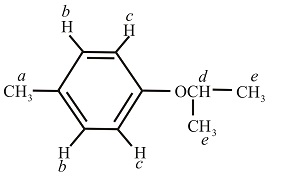
The set of chemically equivalent protons in a compound produces a separate signal in
(a.2)
Interpretation:
Number of signals expected in each of the following compounds in
Concept introduction:
The number of signals in
For each set of chemically equivalent protons, there will be one signal. For example, the
(a.2)
Answer to Problem 47P
Compound (2) will show 5 signals in its
Explanation of Solution
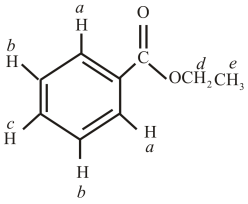
The set of chemically equivalent protons in a compound produces a separate signal in
(a.3)
Interpretation:
Number of signals expected in each of the following compounds in
Concept introduction:
The number of signals in
For each set of chemically equivalent protons, there will be one signal. For example, the
(a.3)
Answer to Problem 47P
Compound (3) will show 4 signals in its
Explanation of Solution
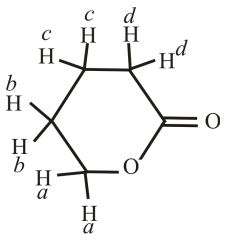
The set of chemically equivalent protons in a compound produces a separate signal in
(a.4)
Interpretation:
Number of signals expected in each of the following compounds in
Concept introduction:
The number of signals in
For each set of chemically equivalent protons, there will be one signal. For example, the
(a.4)
Answer to Problem 47P
Compound (4) will show 2 signals in its
Explanation of Solution
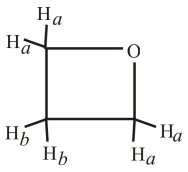
The set of chemically equivalent protons in a compound produces a separate signal in
(a.5)
Interpretation:
Number of signals expected in each of the following compounds in
Concept introduction:
The number of signals in
For each set of chemically equivalent protons, there will be one signal. For example, the
(a.5)
Answer to Problem 47P
Compound (5) will show 3 signals in its
Explanation of Solution
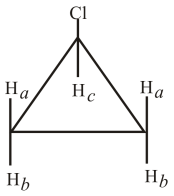
The set of chemically equivalent protons in a compound produces a separate signal in
(a.6)
Interpretation:
Number of signals expected in each of the following compounds in
Concept introduction:
The number of signals in
For each set of chemically equivalent protons, there will be one signal. For example, the
(a.6)
Answer to Problem 47P
Compound (6) will show 3 signals in its
Explanation of Solution
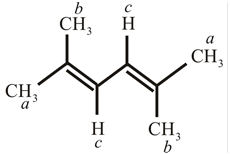
The set of chemically equivalent protons in a compound produces a separate signal in
- (b) (b.1)
Interpretation:
Number of signals expected in each of the following compounds in
Concept introduction:
The signals in the spectrum of a compound are proportional to the number of carbons that are present in the different environment within the molecule. The carbon which is present in the electron-rich environment shows a signal at a lower frequency and vice-versa. Therefore, the carbons that are present nearest to the electron-withdrawing groups produce a high-frequency signal.
- (b) (b.1)
Answer to Problem 47P
Compound (1) will show 7 signals in its
Explanation of Solution
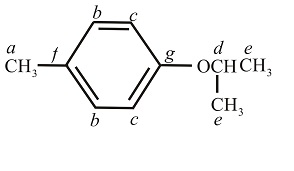
The set of chemically equivalent carbon in a compound produces a separate signal in
(b.2)
Interpretation:
Number of signals expected in each of the following compounds in
Concept introduction:
The signals in the spectrum of a compound are proportional to the number of carbons that are present in the different environment within the molecule. The carbon which is present in the electron-rich environment shows a signal at a lower frequency and vice-versa. Therefore, the carbons that are present nearest to the electron-withdrawing groups produce a high-frequency signal.
(b.2)
Answer to Problem 47P
Compound (2) will show 7 signals in its
Explanation of Solution
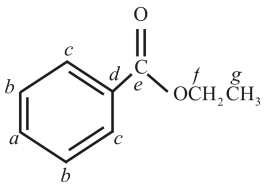
The set of chemically equivalent carbon in a compound produces a separate signal in
(b.3)
Interpretation:
Number of signals expected in each of the following compounds in
Concept introduction:
The signals in the spectrum of a compound are proportional to the number of carbons that are present in the different environment within the molecule. The carbon which is present in the electron-rich environment shows a signal at a lower frequency and vice-versa. Therefore, the carbons that are present nearest to the electron-withdrawing groups produce a high-frequency signal.
(b.3)
Answer to Problem 47P
Compound (3) will show 5 signals in its
Explanation of Solution
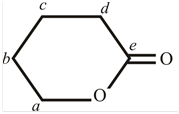
The set of chemically equivalent carbon in a compound produces a separate signal in
(b.4)
Interpretation:
Number of signals expected in each of the following compounds in
Concept introduction:
The signals in the spectrum of a compound are proportional to the number of carbons that are present in the different environment within the molecule. The carbon which is present in the electron-rich environment shows a signal at a lower frequency and vice-versa. Therefore, the carbons that are present nearest to the electron-withdrawing groups produce a high-frequency signal.
(b.4)
Answer to Problem 47P
Compound (4) will show 2 signals in its
Explanation of Solution
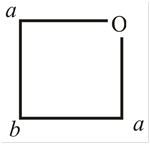
The set of chemically equivalent carbon in a compound produces a separate signal in
(b.5)
Interpretation:
Number of signals expected in each of the following compounds in
Concept introduction:
The signals in the spectrum of a compound are proportional to the number of carbons that are present in the different environment within the molecule. The carbon which is present in the electron-rich environment shows a signal at a lower frequency and vice-versa. Therefore, the carbons that are present nearest to the electron-withdrawing groups produce a high-frequency signal.
(b.5)
Answer to Problem 47P
Compound (5) will show 2 signals in its
Explanation of Solution
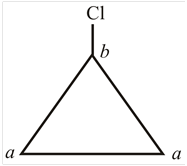
The set of chemically equivalent carbon in a compound produces a separate signal in
(b.6)
Interpretation:
Number of signals expected in each of the following compounds in
Concept introduction:
The signals in the spectrum of a compound are proportional to the number of carbons that are present in the different environment within the molecule. The carbon which is present in the electron-rich environment shows a signal at a lower frequency and vice-versa. Therefore, the carbons that are present nearest to the electron-withdrawing groups produce a high-frequency signal.
(b.6)
Answer to Problem 47P
Compound (6) will show 4 signals in its
Explanation of Solution
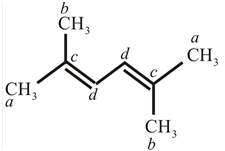
The set of chemically equivalent carbon in a compound produces a separate signal in
Want to see more full solutions like this?
Chapter 14 Solutions
Organic Chemistry Study Guide and Solutions Manual, Books a la Carte Edition (8th Edition)
- Indicate the correct option for the velocity distribution function of gas molecules:a) its velocity cannot be measured in any other way due to the small size of the gas moleculesb) it is only used to describe the velocity of particles if their density is very high.c) it describes the probability that a gas particle has a velocity in a given interval of velocitiesd) it describes other magnitudes, such as pressure, energy, etc., but not the velocity of the moleculesarrow_forwardDraw the skeletal structure of the alkane 4-ethyl-2, 2, 5, 5- tetramethylnonane. How many primary, secondary, tertiary, and quantenary carbons does it have?arrow_forwardDon't used Ai solutionarrow_forward
- Don't used Ai solutionarrow_forwardThe number of imaginary replicas of a system of N particlesA) can never become infiniteB) can become infiniteC) cannot be greater than Avogadro's numberD) is always greater than Avogadro's number.arrow_forwardElectronic contribution to the heat capacity at constant volume A) is always zero B) is zero, except for excited levels whose energy is comparable to KT C) equals 3/2 Nk D) equals Nk exp(BE)arrow_forward
- Please correct answer and don't used hand raitingarrow_forwardCalculate the packing factor of CaTiO3. It has a perovskite structure. Data: ionic radii Co²+ = 0.106 nm, Ti4+ = 0.064 nm, O² = 0.132 nm; lattice constant is a = 2(rTi4+ + ro2-). Ca2+ 02- T14+ Consider the ions as rigid spheres. 1. 0.581 or 58.1% 2. -0.581 or -58.1 % 3. 0.254 or 25.4%arrow_forwardGeneral formula etherarrow_forward
- Please provide the retrosynthetic analysis and forward synthesis of the molecule on the left from the starting material on the right. Please include hand-drawn structures! will upvote! Please correct answer and don't used hand raitingarrow_forwardPlease provide the retrosynthetic analysis and forward synthesis of the molecule on the left from the starting material on the right. Please include hand-drawn structures! will upvote!arrow_forward(please correct answer and don't used hand raiting) Please provide the retrosynthetic analysis and forward synthesis of the molecule on the left from the starting material on the right. Please include hand-drawn structures! will upvote!arrow_forward
 Organic ChemistryChemistryISBN:9781305580350Author:William H. Brown, Brent L. Iverson, Eric Anslyn, Christopher S. FootePublisher:Cengage Learning
Organic ChemistryChemistryISBN:9781305580350Author:William H. Brown, Brent L. Iverson, Eric Anslyn, Christopher S. FootePublisher:Cengage Learning

